Bioaccumulation of heavy metals in different components of two Lake Ecosystem
AMIYA TIRKEY1 * , P. Shrivastava2 and A. Saxena1
1
M.P. Pollution Control Board,
Bhopal,
462 016
India
2
Department of Life Sciences and Limnology,
Barkatullah University,
Bhopal,
India
DOI: http://dx.doi.org/10.12944/CWE.7.2.15
Copy the following to cite this article:
Tirkey A, Shrivastava P, Saxena A. Bioaccumulation of Heavy Metals in Different Components of two Lakes Ecosystem. Curr World Environ 2012;7(2):293-297 DOI:http://dx.doi.org/10.12944/CWE.7.2.15
Copy the following to cite this URL:
Tirkey A, Shrivastava P, Saxena A. Bioaccumulation of Heavy Metals in Different Components of two Lakes Ecosystem. Curr World Environ 2012;7(2):293-297. Available from: http://www.cwejournal.org/?p=2890
Download article (pdf) Citation Manager Publish History
Select type of program for download
| Endnote EndNote format (Mac & Win) | |
| Reference Manager Ris format (Win only) | |
| Procite Ris format (Win only) | |
| Medlars Format | |
| RefWorks Format RefWorks format (Mac & Win) | |
| BibTex Format BibTex format (Mac & Win) |
Article Publishing History
| Received: | 2012-07-12 |
|---|---|
| Accepted: | 2012-09-17 |
Contamination of aquatic ecosystems by heavy metals has been observed in sediment, water and aquatic flora and fauna (Forstner and Whittmann, 1983). Different aquatic organisms often respond to external contamination in different ways, where the quantity and form of the element in water, sediment or food will determine the degree of accumulation (Langston & Spence, 1995). Heavy metals entering the aquatic ecosystem originate from different sources such as decay of plants and vegetation, atmospheric particulate, discharge of domestic and municipal wastes etc. (Abo et al., 2005, Fatma A.S.M., 2008).
Like soils in the terrestrial system, sediment is the primary sinks for heavy metals in the aquatic environment. Heavy metals once absorbed on the sediments sre not freely available for aquatic organisms. Under changing environmental conditions (temp., pH, redox potential, salinity) of the overlying water these toxic metals are released back to the aqueous phase (Soares et al., 1999). Hence, the assessment of sediment is significant to study the risk of aquatic ecosystem. Similarly fishes assimilate these heavy metals through ingestion of water, food materials and constant ion exchange process of dissolved metals across lipophilic membranes like gills or adsorption on surface membrane like skin. The region of accumulation of heavy metals within fish varies with route of uptake, heavy metal species and species of fish concerned. Their potential use as biomonitors is therefore significant in the assessment of bioaccumulation and biomagnifications of contaminants within the ecosystem.
Material and Methods
Study Area
Two major artificial water resources were selected for the study. Both lakes are of commercial importance due to their beautiful location, but also face severe environmental stress.
Shahpura Lake (23º 18' N, 77º 27' E) and 488 m above mean sea level. The lake covers an area of 2.6 km2, has a mean depth of 3.0 m and a catchment’s area of 8.3 km2. Approximately 110 tons / day solid waste is generated within the catchment and 9.6 millions litres per day of sewage enters the lake from residential areas in the catchment (Shrivastava et al., 2003). It is located in the south east of the city and receives heavy loads of domestic and municipal sewage. The lake water is used in pisciculture, idol immersion, cattle bathing, washing and minor irrigation.
Upper Lake (23°12' E - 23°16’N, 77° 18' - 77° 23' E) has an area of 31 km², and drains a catchment or watershed of 361 km². The watershed of the Upper Lake is mostly rural, with some urbanized areas around its eastern end. The topography of the lake indicates that the basin is natural, as northern and southern sides of the lake are hilly while the western end has flat contours and forms the agricultural land (Dixit S. et al., 2005). It is a major source of drinkable water for the residents of the city, serving around 40% of the residents with nearly 30 million gallons per day. The lake water is used for fishing, boating, idol immersion and irrigation.
Field Sampling
The sampling of water and sediment from Shahpura and Upper Lake were based on the principles and procedures outlined in standard methods for the examination of heavy metals in water (APHA, 1995). Sampling was done each month of summer season (March-May, 2010). Fish samples were collected from the local fishermen and brought to laboratory for dissection and further heavy metal determination.
Heavy Metal Determination
Surface water was collected by dipping one litre capacity white jerricane. The water sample was acidified with 2ml HNO3 at the sampling site. The heavy metals in water samples were analysed by AAS. Sediment samples were dried at room temperature and ground with pestle and mortar. They were further sieved through 0.2mm mesh size filter and stored in clean polybags till analysis. With the help of stainless steel scalpel liver, gills and muscle tissues of fishes were removed. The acid digestion of sediment and fish tissues was done according to the standard methods. The concentrations of the heavy metals were estimated with Atomic Absorption Spectrophotometer (GBC Avanta PM, Australia). All reagents used were of AnalaR grade and all glass wares and polypropylene were properly cleaned with acid cleansing reagents and rinsed thoroughly with distilled deionised water.
Results and Discussion
The concentrations of heavy metals estimated in sediment, water and fish samples collected from both lakes are given in Table 1.
The concentrations of heavy metals varied in all different components.
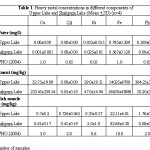 |
Table 1: Heavy metal concentrations in different components of Upper Lake and Shahpura Lake (Mean ±SD) (n=4) Click here to View table |
Copper
It is essential for human life, but in high doses it may cause anaemia, liver and kidney damage, stomach and intestinal irritation etc. The average concentration of Cu observed were, in water (0.00 ± 0.00 mg/l, 0.001 ± 0.001 mg/l) and fishes (0.7±0.2 mg/kg, 0.61±0.17 mg/kg) in Upper and Shahpura Lake respectively, which were within the limits of WHO (2004). In sediment samples Upper Lake accumulated 32.75±19.88mg/kg whereas Shahpura Lake accumulated 233.45±238.54mg/kg of Cu (Fig. 1). Traces of Cu in drinking water may be due to the lining of copper pipes, as well as from additives used to control algal growth.
Cadmium
Cadmium derives its toxicological properties from its chemical similarity to Zn an essential micronutrient for plants, animals and humans. Cd is biopersistent and once absorbed by an organism, remains resident for many years (over decades for humans) although it is eventually excreted. High exposure leads to obstructive lung disease and can even cause lung cancer. Cd produce bone defects in humans and animals. Cd was below detectable limit (0.00mg/l) in water of both lakes (Fig. 2). Fish muscles showed 0.726±0.045mg/kg and 0.61±0.17mg/kg of bioaccumulation respectively in Upper and Shahpura Lake.
Nickel
Small amount of Ni is needed by human body to produce red blood cells, however, in excessive amounts, it can become mildly toxic. Short term over exposure to Ni is not known to cause any health problems, but long term exposure can cause decreased body weight, heart and liver damage and skin irritation. Average concentration of Ni was 29.0±19.51 mg/kg and 47.0±14.94 mg/kg in sediment, 0.032±0.015 mg/l and 47.0±14.94 mg/l in water and 0.33±0.57 mg/kg and 2.0±1.0 mg/kg in muscles of fishes of Upper and Shahpura Lake respectively (Fig. 3). Fishes of polluted water body showed bioaccumulation of Ni and may be considered unsafe for human consumption.
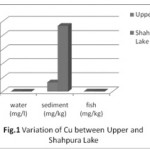 |
Figure 1: Variation of Cu between Upper and Shahpura Lake Click here to View table |
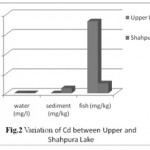 |
Figure 2: Variation of Cd between Upper and Shahpura Lake Click here to View table |
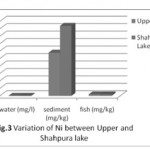 |
Figure 3: Variation of Ni between Upper and Shahpura Lake Click here to View table |
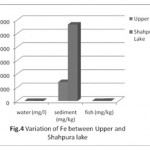 |
Figure 4: Variation of Fe between Upper and Shahpura Lake Click here to View table |
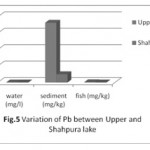 |
Figure 5: Variation of Pb between Upper and Shahpura lake Click here to View table |
Iron
Fe is essential for plant and animal metabolism. Fe overload in man is not common but may occur due to genetic defect. Such overload results in oxidative degradation of lipids, destruction of intercellular and extracellular proteins and DNA damage. Extreme values of Fe was detected in fish muscles i.e. 22.11±4.01 mg/kg and 82.66±4.50 mg/kg in Upper and Shahpura Lake which is much higher than WHO (2004) limits. The reason may be because of absorption of Fe residues through the intestinal walls of fishes (Bu-Olayan A.H., 2008). Likewise sediment samples showed the concentration of 14025±6709 mg/kg and 56650±43888 mg/kg in Upper and Shahpura Lake respectively (Fig. 4). Water showed permissible limits for safe consumption of humans and aquatic life in freshwater and polluted lakes.
Lead
Lead in the environment arises from both natural and anthropogenic sources. Exposure can occur through drinking water, food, air, soil and dust from old paint containing Pb. High levels of exposure may result in biochemical effects in humans which in turn cause problems in the synthesis of haemoglobin, effects on the kidneys, gastrointestinal tract, joints and reproductive system, and acute or chronic damage to the nervous system. The average concentration of Pb in sediment is 364.25 mg/kg and 50.20 mg/kg in Upper and Shahpura Lake respectively (Fig. 5). This value is very high when compared to the average Pb levels in Indian river sediment of about 14mg/kg (Dekov et al., 1999). The Pb concentration in water of Upper Lake, 0.109 mg/l is above the permissible limits for drinking water by WHO (2004). This indicates a high anthropogenic activity surrounding the lake which includes idol immersion, motor boats for recreation, traffic pollution. Fishes of Upper Lake showed higher bioaccumulation of 1.76±0.25mg/kg as compared to Shahpura Lake.
The results of this study showed that the water, sediment and fish of both lakes were contaminated by the heavy metals Cu, Cd, Ni, Fe and Pb. Sediments from both lakes showed high concentration of toxic metals. The results further showed that water could be used for irrigational purposes but unsafe for drinking as traces of Pb found in Upper Lake. These results agree with that obtained by Saxena A. et al., (1998) and Shahpura Lake is fit for pisciculture and minor irrigation. Fishes of Upper Lake are safe for human intake. It is proposed that continuous monitoring and intensive management in the area should be carried out to ascertain long term effects of anthropogenic impact and to assess the effectiveness of minimising the human activity to maintain our lake ecosystem.
Acknowledgement
The author would like to thank the staff of Central Laboratory, M.P. Pollution Control Board, Bhopal for providing support during sampling and laboratory facilities to fulfil my experiments. Special thanks to Dr. Sadhya Mokhle for her assistance in heavy metal analysis in AAS.
References
- Forstner, U. and G. T. Whittmann: Metal pollution in aquatic environment, Springer-Verlag, Berlin, Heidelberg, New York, Tokyo, pp 486 (1983).
- W.J. Langston and S.K. Spence: Metal speciation and bioavailability in aquatic systems. A Tessier & D.R. Turner, Editors, IUPAC Series on Analytical and Physical Chemistry of Environmental Systems, Vol. 3 Chapter 9 (1995).
- Abo El Ella, S.M., M.M. Hosny and M.F. Bakry: Utilizing fish and aquatic weeds infestation as bioindicators for water pollution in Lake Nubia, Sudan. Egypt. J. Aq. Biol Fish. 9:63-84 (2005).
- Fatma A.S. Mohamed: Bioaccumulation of selected metals and histopathological alterations in tissues of Oreochromis niloticus and Lates niloticus from lake Nasser, Egypt. Glob. Veter. 2(4): 205-218 (2008).
- Soares, H.M.V.M., R.A.R. Boaventura, A.A.S.C. Machado and J.C.G. Esteves da Silva: Sediments as monitors of heavy metal contamination in Ave river basin (Portugal): multivarioate analysis of data. Env. Poll. 105:311-323 (1999).
- Shrivastava P., Saxena A. and Swarup A: Heavy metal pollution in a sewage fed lake of Bhopal, (M.P.) India. Lakes and Res, 8: 1-4 (2003).
- Dixit S., Gupta S.K. and Tiwari Suchi: A nutrient overloading of a freshwater lake in Bhopal, India. Earth Day, Issue 21 (2005).
- APHA: Standard methods for the examination of water and wastewater 19th Ed. American Public Health Association (1995).
- P. Sannasi and S. Salmijah, Orient J. Chem., 27(2): 461-467 (2011).
- Dekov, V.M., Subramanian, V., Van Grieken, R.: Chemical composition of riverine suspended matter and sediments from the Indian sub-continent. In: Ittekkot, V., Subramanian, V. And Annadurai S. (Eds), Biogeochemistry of Rivers in Tropical South and Southeast Asia. Heft 82, SCOPE Sonderband Mitteilug aus dem Geologisch-Palaontolgischen Institut der Universitat, Hamburg, pp. 99-109 (1999).
- WHO: Guidelines for Drinking Water Quality, 3rd Ed. World Health Organisation, Geneva (2004).
- B.M. Bheshdadia, D.S. Kundariya and P.K. Patel, Orient J. Chem., 27(2): 685-689 (2011).
- Bu-Olayan A.H., Thomas B.V. :Trace metals toxicity and bioaccumulation in mudskipper Periophthalmus waltoni Koumans 1941(Gobiidae: Perciformes). T. Jour. of Fisheries and Aquatic Sciences, 8:215-218 (2008).
- Dixit S., Gupta S.K. and Tiwari Suchi: A nutrient overloading of a freshwater lake in Bhopal, India. Earth Day, Issue 21(2005).
- Saxena A. and Shrivastava P. And Swarup A.: Heavy metal pollution in a tropical wetland. Lakes and Res (1998).







